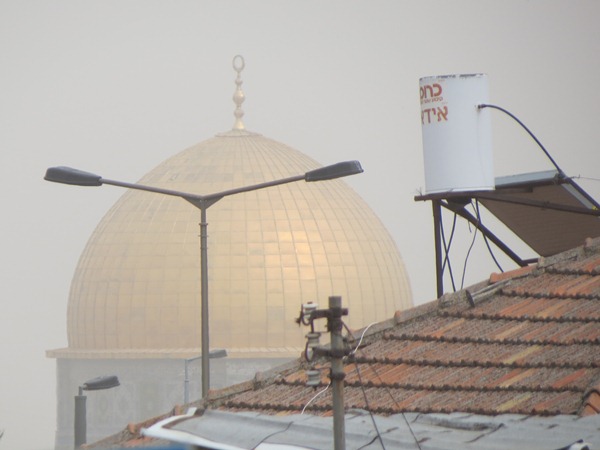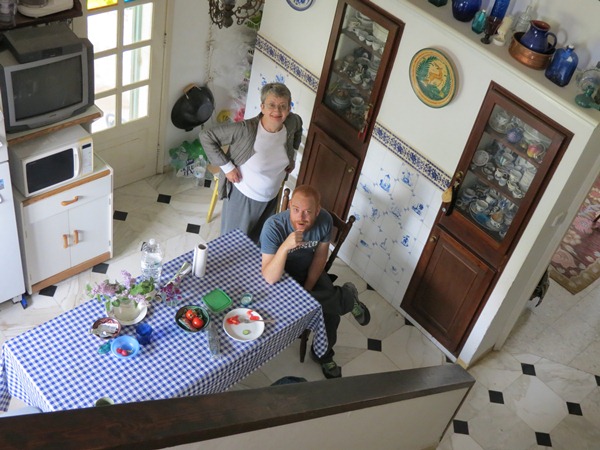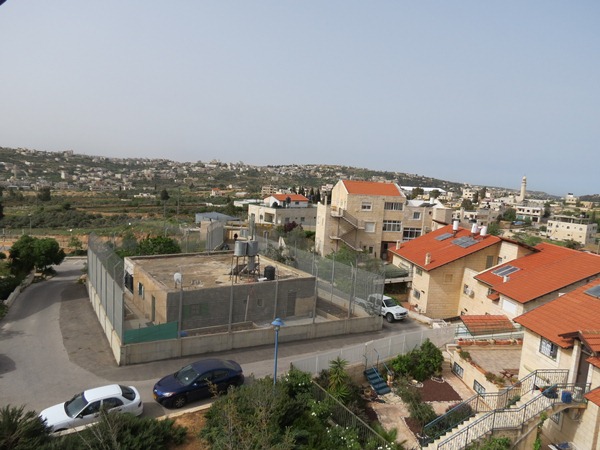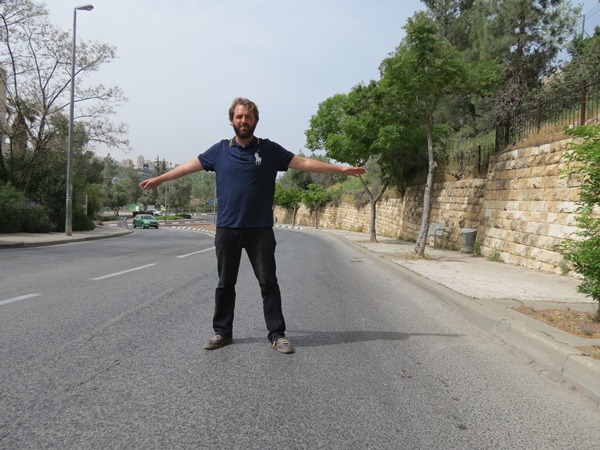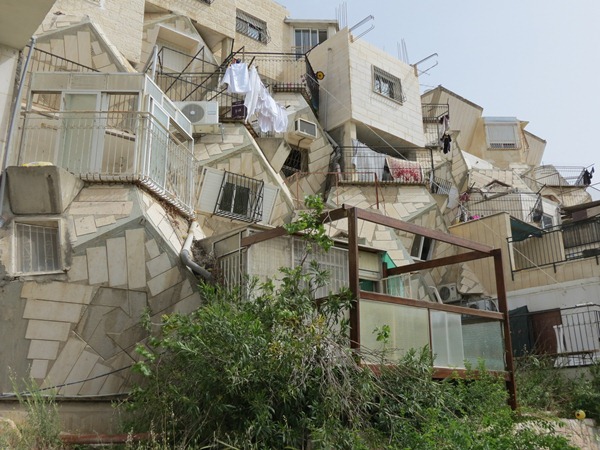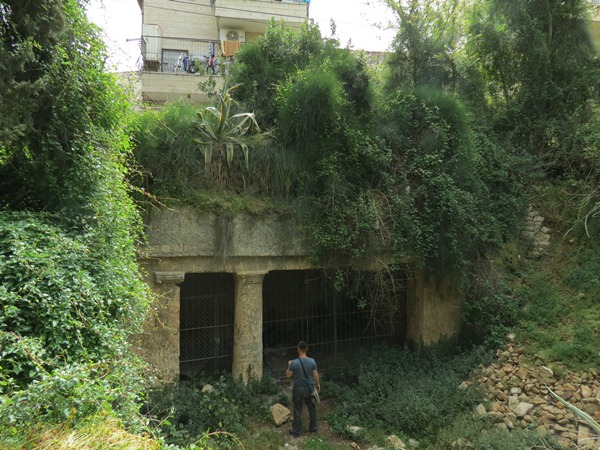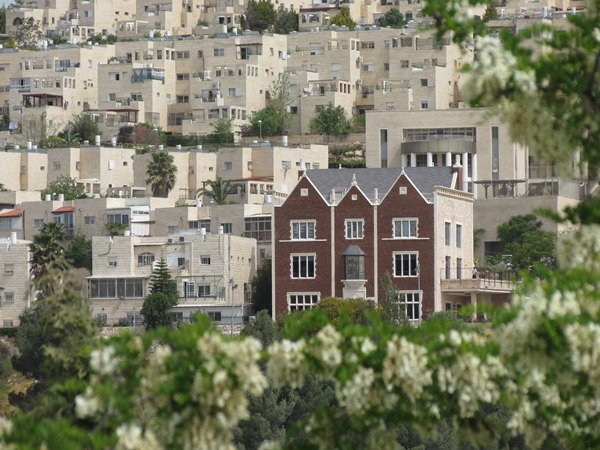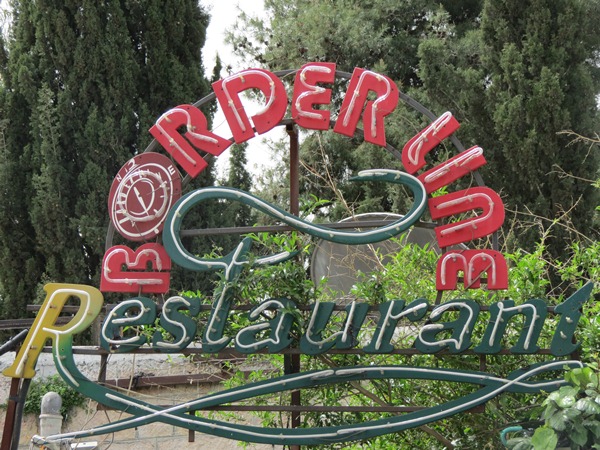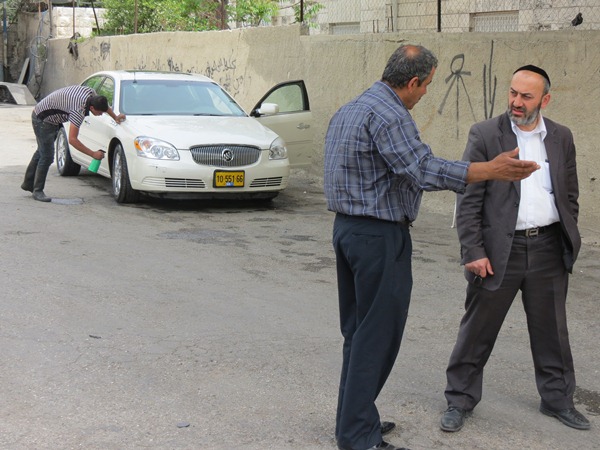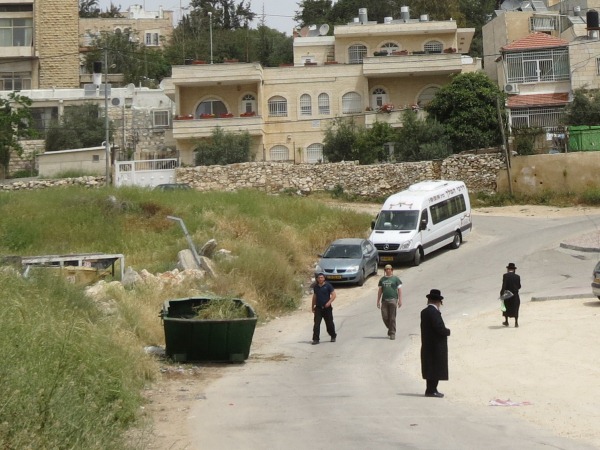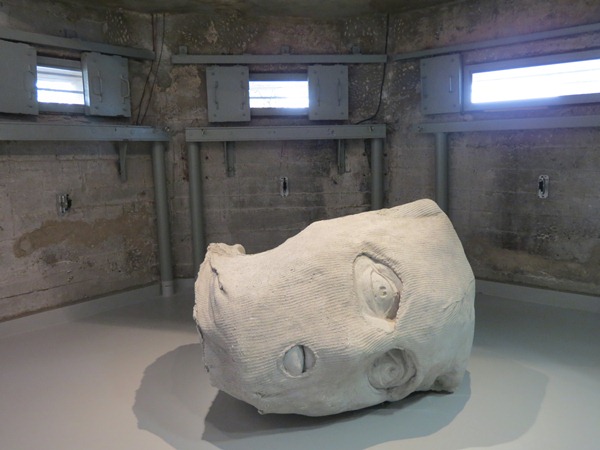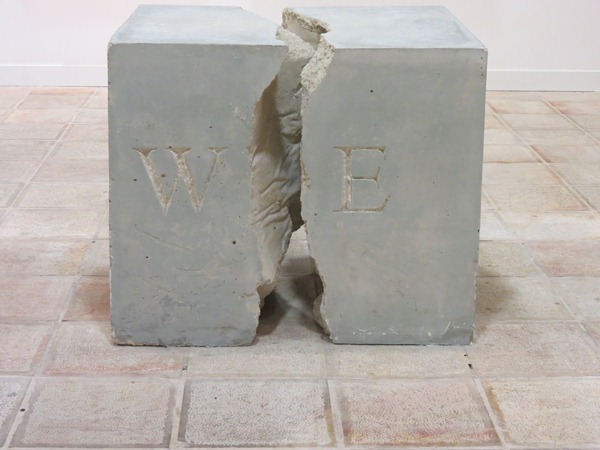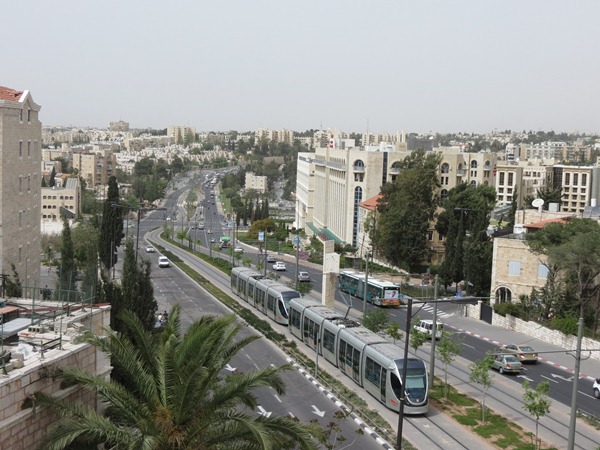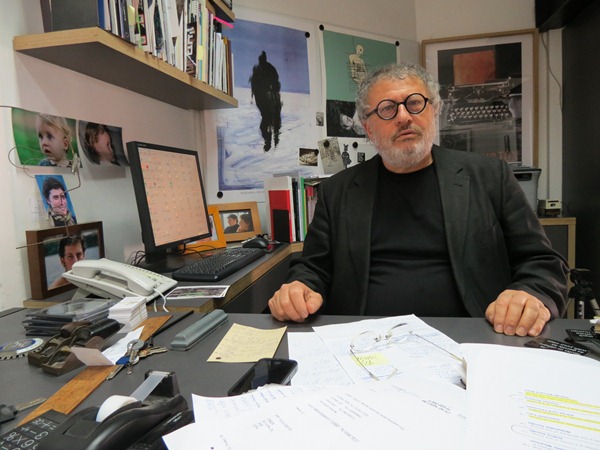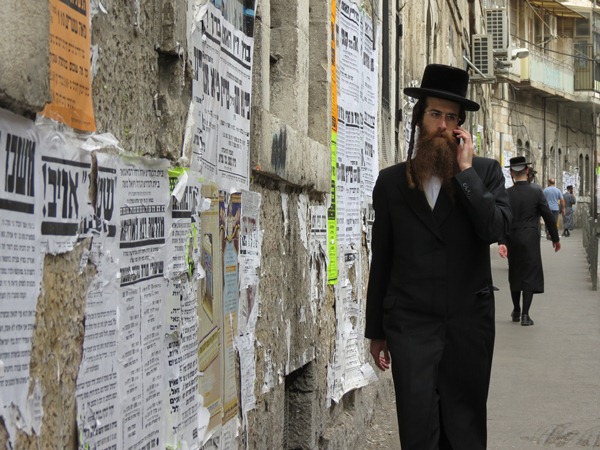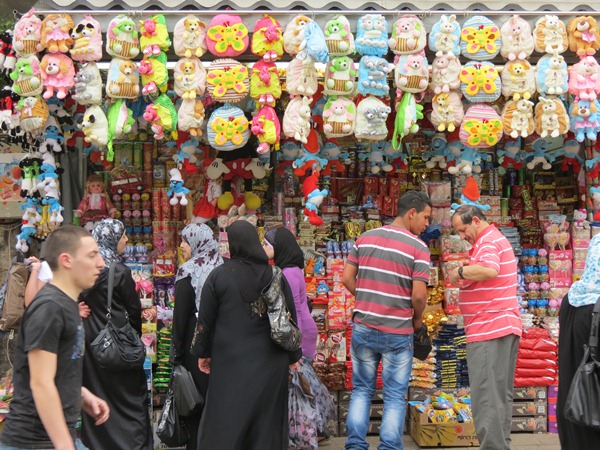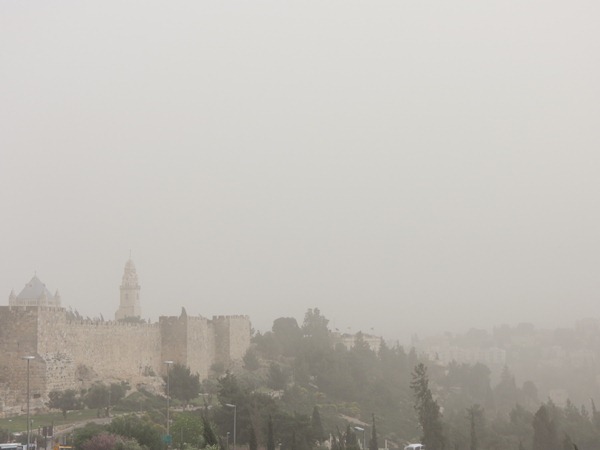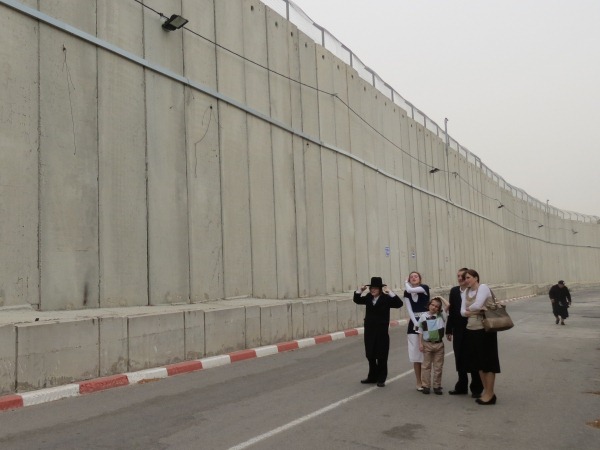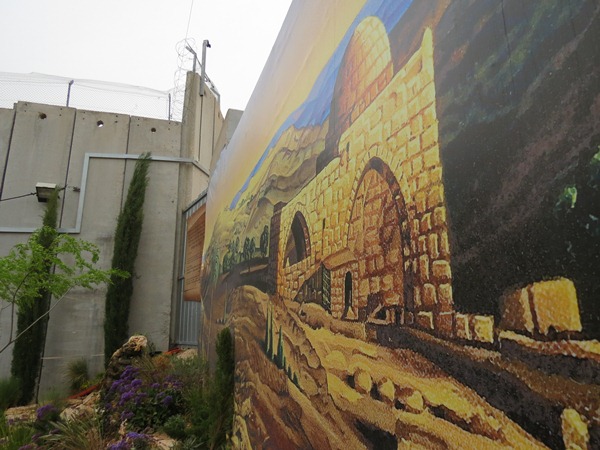From Ramot to Rachel’s tomb via Brooklyn, a haunted house, a threat of very painful eternal damnation and two fjords.
Ira, Ezra and myself are having breakfast in the sunny kitchen of Givon Hakhadasha. Ira eats what she terms a “kibbutz” breakfast: white cheese spread, some bread and a chopped salad of tomatoes and cucumber. She talks of the settlement’s oddities, from an eccentric neighbor who claims unconvincingly to have served as a secret agent, to a peacock whom she once saw walking down the leafy streets, next to a little girl who tried to feed it ice cream.
Another oddity involves a Palestinian man named Mahmoud Saberi, whose house gradually became engulfed by the settlers’ houses. Saberi refused to leave his property, and it was consequently fenced off by the settlement to keep him out, allowing him a narrow opening in the direction of the nearby village. Saberi’s house now sits at the end of a fjord of fence, connected to the settlement’s own enclosing fence.
Ezra takes me to see this.
Then he drives us to the north of Jerusalem, to the colossal suburban neighborhood of Ramot, which was built post 1967 on both sides of the Green Line. At the time, and indeed as late as the 1990s, it was illegal for maps printed in Israel to show this line, and Ramot’s own planners may not have known precisely where it ran. I am fairly confident that most people living here today have no clue where Israel ends and the West Bank begins, nor in which territory they live. The dotted line on “Google maps” is surprisingly easy to ignore.
Where the two of us reach that dotted line, it unassumingly crosses the most mundane street. Of all the invisible borders I have crossed so far, this is the most invisible.
Talk about an oddity… In fact, lets do talk about oddities. I’m something of an expert on the subject, having once composed a book entitled “Wonderland: Strange Places, Surprises and Mysteries in Israel.” Many of the sites I documented there were in and around Jerusalem, and quite a few touched on the old 1949 armistice line, which used to divide the city physically and does so now in every other way.
The walls and fences of the separation barrier surround Jerusalem, keeping all of it, east and west, within Israel’s hold. The old dividing line remains meaningful, however, as it still splits the city by language, by mentality, by appearance, by religion, by rights (Israeli Jerusalemites are citizens, Palestinians are “residents”) and by the municipality’s willingness to remove garbage.
This line is known as “The Red Line,” an indication that when charting the armistice maps, the green crayon was put aside and a different color was used for dividing Jerusalem. My plan today is to follow the Red Line from north to south, pointing out curiosities along the way.
Allow me to begin with Ramot’s own “beehive blocks,” designed by architect Zvi Hecker in the 1970s. They are widely considered to be unlivable.
Ezra accompanies me to the mouth of a 2000-year old tomb in the neighborhood of Sanhedria. Jerusalem is the sort of town where residential neighborhoods simply rise out of miniature Petras. It’s normal here. The dead dwell among us.
Sometimes they even dwell among us in the comfort of their own homes. Followers of Chabad Lubavitch Hassidic movement built two exact copies of a house standing in Crown Heights, Brooklyn. The much admired Rabbi Menachem Mendel Schneerson, whom many Chabadniks believe to be the messiah, used to reside at 770 Eastern Parkway in Brooklyn. The replicas of that address were made with such reverence and attention, that a squeaking stair in the original house squeaks also at Kfar Chabad, next to Tel Aviv’s Ben Gurion Airport, and right here in the settlement of Ramat Shlomo, East Jerusalem.
Ezra goes to work, and I stop at the a cafe for coffee and a respite from the heat. It is appropriately named for its location, but so overpriced that it may well be named another oddity.
I am in Sheikh Jarrah, A Palestinian neighborhood that became notorious in 2009, when Israel evicted several Palestinian families from their houses so ideological settlers could move in instead. According to the state and settlers, papers prove that the land was bought by a now defunct Jewish organization prior to 1948. Sounds good, property bought is property owned. So now do Palestinians get to retake Old Jaffa? Will the army and police cover them during the takeover and protect them thereafter?
What, no? but –
The eviction of the families was so obscene that it provoked a truly popular human rights campaign, but Israel did not budge. The spreading of Jewish settlers across East Jerusalem is regarded as a cause celebre, both by the government and by the city’s current mayor, Nir Barkat. Confiscated properties and sprung-overnight-settlements multiply rapidly around the city, typically inhabited by extremists who do not come to be good neighbors.
Some degree of coexistence persists. Here is a Palestinian. Rabbi Yaakov Hillel’s chauffeur brought the Rabbinical Buick for a wash, and is having a friendly chat with the owner of the car wash. Above their heads, a Hebrew sign still offers special Passover washes, to clean the vehicle of traces of baked goods.
As I venture deeper, the disturbing truth reveals itself. I see no Palestinians on the streets at the very heart of the neighborhood, only settlers and ultra-Orthodox Jews. The latter come to pray at a newly popular ancient tomb, attributed to Shimon Hatzadik (Simon the Just), one of the last members of the Great Assembly.
Once I descend towards the tomb, the Israeli flags and the inevitable IDF rooftop position, my presence provokes interest. A settler teenager approaches me and asks what I might want.
“I want to check this place out. It’s intetresting.”
“Oh yeah?” by my naked scalp he can tell that I am not of his own, and so I must be the enemy, the fifth column. The monsterous “Smolan” (leftist). “How is it interesting, ha?”
“Things happen here, people get thrown out of houses.”
“Oh yeah?” his face turns instantly purple. “The Arabs stole this entire country from us! Go back to history. It is ours! You can argue with me, you can, but that would be banging your head against the wall, because I have my own truth, you see, and this country is only ours! So You can argue, argue, yeah, you can argue, but in the end you’ll burn in hell and they’ll stick a skewer up your ass!!” and he turns away and walks.
These are unexpected words to hear from a religious youth. His friend is quick to apologize and the older Haredi passerby turns to me and suggests: “Go pray at the tomb, it’ll solve all your problems.”
Dear god. If only.
I don’t make it to the tomb. It’s not really a place I would like it to be. Rather, I head south and go visit a haunted house.
Raphi Etgar, a graphic designer and curator, started “Museum on the Seam” in an old house that served as an IDF position in 1967. The windows are still narrowed with concrete to provide safe sniper positions, but the shots are now aimed at the heart and mind, and the weapon is art, political art.
The current exhibition deals with memory and its ability to act as a warning. A huge ski-masked head by local artist Erez Israeli evokes the head of the sniper who may have held this position. A broken block that reads “we”, cast by French-Algerian Djamal Koken, appears like a summary of everything I have been through so far on this journey, and especially today, here, in a city that is two cities, on a border that is a border that isn’t a border.
Maya, who minds the museum’s counter, reads +972 and recognizes me, so I get an audience with the museum’s founder and this show’s curator. Raphi’s office is situated on the building’s roof. The view to what once a slender no man’s land and is now major throughfare and a light-rail route, is perfect.
Raphi confirms that the house is haunted. “This house has been through an historical maelstrom that it cannot forget nor ignore. Before it was occupied by the army, this was a house where a Palestinian family lived. The contradictions it contains are contractions we must respond to, and I believe that a place where once people fought is a place where we must talk peace.
Besides the history, there’s the location. “We border the most ultra-Orthodox neighborhood in the Middle East on one side,” Raphi continues “Then to the south is Musrara, where the Mizrachi “Panthers” once raged, and across the street are the Palestinians. How many political and cultural borders can surround one building?”
This place really is lost in the fifth dimension. The “most ultra-Orthodox neighborhood” to which Raphi refers is Me’a Shearim, where makeshift posters full of political messages, angry prophecies and community gossip remain a favorite media source in the age of the iphone.
Right across the way, is the heart of Palestinian Jerusalem, with its ceaseless bustle, its muezzins and its fried chicken joints. No Berlin wall stands along this street, it’s equipped with clearly painted crosswalks, and yet the crowd on either side is nearly perfectly homogeneous.
This entire city is unexplainable, a mystery with a mayor. Just as I begin to follow its fabled walls, a freak storm of dust take over everything, breathing becomes hard and walking impossible. Then summer turns to winter in a matter of minutes and I must seek shelter in a bus.
As the bus travels south, it takes me past other roadside attractions. There is, for example a peculiar cable car that was used by the Palmach to pass food and ammunition into the besieged Jewish quarter in 1948. The cable holding it spans the breadth of the valley of Hinnom, and was once traversed on foot by tight-rope-walker Philippe Petit.
Further to the south, in the neighborhood of Jabel Mukaber is something far stranger: a road on which things seem to be naturally drawn uphill, by virtue of some reverse gravity (In fact it is by virtue of an optical illusion that turns downhill into uphill in our minds). There are so many things to show, but photographs are bound to come out awful in such weather, So I might as well head on south to the biggest oddity of all.
Like many Jerusalem landmarks, It’s a wall, a very tall wall. The separation barrier in Beit Jala is eight meters tall and as gray as the life of a North Korean paper boy. While it does separate Jerusalem and metropolitan Bethlehem, it also penetrates into the town of Beit Jala, creating a meandering corridor that ends at the site of Rachel’s Tomb. It thus allows Jewish Israelis unobstructed passage to the holy site, while dissecting an entire neighborhood and a refugee camp on the other side.
The tomb itself, which for centuries was a beautiful domed structure, standing on the country roadside between two historical and beautiful cities, and precious to Jews everywhere, has been entirely cast in concrete and is now literally a bunker. This doesn’t seem to bother the faithful, who stop to capture a Kodak moment.
Next to the tomb is a depiction of what it had once looked like. This day began with a tentacle of fence that seems to protrude into Givon Hahadasha and with a dropped jaw. It ends with a tentacle of concrete that sticks into Beit Jala, and with a shed tear. I cheer myself with a song, a weird song of course, and hum the words of Syd Barret while waiting for a lift out of this cul de sac.
The madcap laughed at the man on the border
hey ho, huff the Talbot
the winds they blew and the leaves did wag
they’ll never put me in their bag
the seas will reach and always seep
so high you go, so low you creep
the wind it blows in tropical heat
the drones they throng on mossy seats
the squeaking door will always squeak
two up, two down we’ll never limit
so merrily trip forgo my side
Please leave us here
close our eyes to the octopus ride.
More lyrics: http://www.lyricsmania.com/octopus_lyrics_syd_barrett.html
All about Syd Barrett: http://www.musictory.com/music/Syd+Barrett
_______________________________________
The Round Trip thus far!
View Larger Map
Thanks for reading and taking part in the adventure. All writing on this site is done voluntarily, so if any of you would like to pitch in directly for my travel expenses, please click here or on the “donate” button at the top of this page to do so. I’m deeply grateful to those who already donated. Thank you so much! This project would be impossible if not for you.
Relive the first two journeys:
The September Journey
The Christmas Journey


